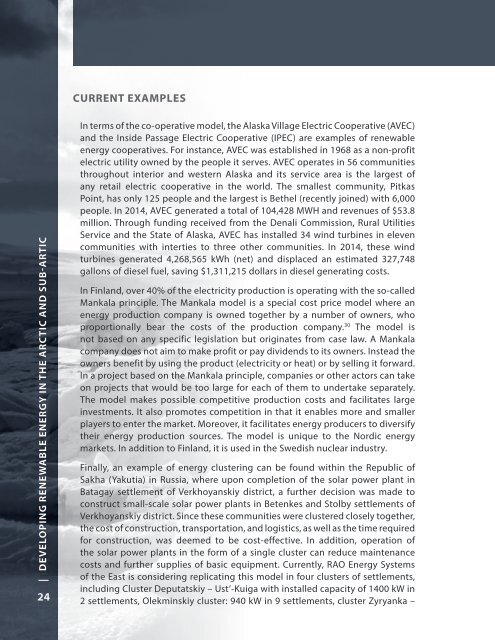DEVELOPING RENEWABLE ENERGY IN ARCTIC AND SUB-ARCTIC REGIONS AND COMMUNITIES
FulbrightArcRenewableEnergy
FulbrightArcRenewableEnergy
You also want an ePaper? Increase the reach of your titles
YUMPU automatically turns print PDFs into web optimized ePapers that Google loves.
CURRENT EXAMPLES<br />
| <strong>DEVELOP<strong>IN</strong>G</strong> <strong>RENEWABLE</strong> <strong>ENERGY</strong> <strong>IN</strong> THE <strong>ARCTIC</strong> <strong>AND</strong> <strong>SUB</strong>-ARTIC<br />
24<br />
In terms of the co-operative model, the Alaska Village Electric Cooperative (AVEC)<br />
and the Inside Passage Electric Cooperative (IPEC) are examples of renewable<br />
energy cooperatives. For instance, AVEC was established in 1968 as a non-profit<br />
electric utility owned by the people it serves. AVEC operates in 56 communities<br />
throughout interior and western Alaska and its service area is the largest of<br />
any retail electric cooperative in the world. The smallest community, Pitkas<br />
Point, has only 125 people and the largest is Bethel (recently joined) with 6,000<br />
people. In 2014, AVEC generated a total of 104,428 MWH and revenues of $53.8<br />
million. Through funding received from the Denali Commission, Rural Utilities<br />
Service and the State of Alaska, AVEC has installed 34 wind turbines in eleven<br />
communities with interties to three other communities. In 2014, these wind<br />
turbines generated 4,268,565 kWh (net) and displaced an estimated 327,748<br />
gallons of diesel fuel, saving $1,311,215 dollars in diesel generating costs.<br />
In Finland, over 40% of the electricity production is operating with the so-called<br />
Mankala principle. The Mankala model is a special cost price model where an<br />
energy production company is owned together by a number of owners, who<br />
proportionally bear the costs of the production company. 30 The model is<br />
not based on any specific legislation but originates from case law. A Mankala<br />
company does not aim to make profit or pay dividends to its owners. Instead the<br />
owners benefit by using the product (electricity or heat) or by selling it forward.<br />
In a project based on the Mankala principle, companies or other actors can take<br />
on projects that would be too large for each of them to undertake separately.<br />
The model makes possible competitive production costs and facilitates large<br />
investments. It also promotes competition in that it enables more and smaller<br />
players to enter the market. Moreover, it facilitates energy producers to diversify<br />
their energy production sources. The model is unique to the Nordic energy<br />
markets. In addition to Finland, it is used in the Swedish nuclear industry.<br />
Finally, an example of energy clustering can be found within the Republic of<br />
Sakha (Yakutia) in Russia, where upon completion of the solar power plant in<br />
Batagay settlement of Verkhoyanskiy district, a further decision was made to<br />
construct small-scale solar power plants in Betenkes and Stolby settlements of<br />
Verkhoyanskiy district. Since these communities were clustered closely together,<br />
the cost of construction, transportation, and logistics, as well as the time required<br />
for construction, was deemed to be cost-effective. In addition, operation of<br />
the solar power plants in the form of a single cluster can reduce maintenance<br />
costs and further supplies of basic equipment. Currently, RAO Energy Systems<br />
of the East is considering replicating this model in four clusters of settlements,<br />
including Cluster Deputatskiy – Ust’-Kuiga with installed capacity of 1400 kW in<br />
2 settlements, Olekminskiy cluster: 940 kW in 9 settlements, cluster Zyryanka –


